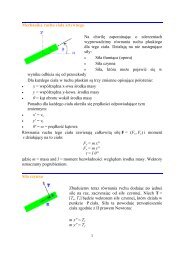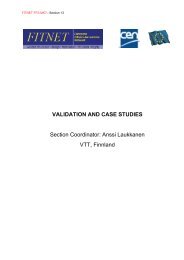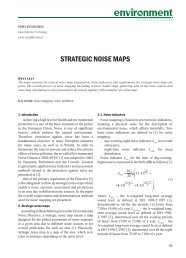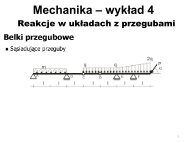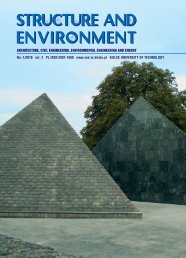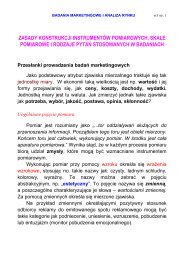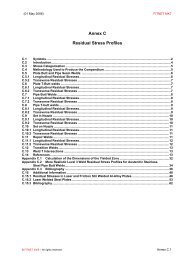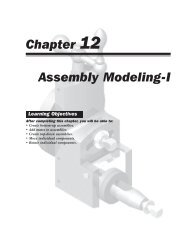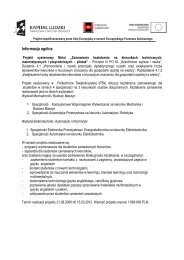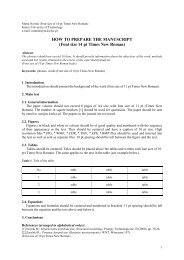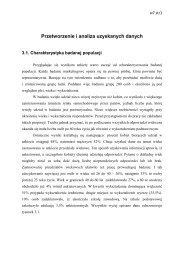STRUCTURE AND ENVIRONMENT STRUCTURE AND ...
STRUCTURE AND ENVIRONMENT STRUCTURE AND ...
STRUCTURE AND ENVIRONMENT STRUCTURE AND ...
Create successful ePaper yourself
Turn your PDF publications into a flip-book with our unique Google optimized e-Paper software.
Tomasz Arciszewski, Jeffrey Russell<br />
be represented as heuristics (heuristic directives)<br />
formulated for various specific situations. Such<br />
heuristics are called ʺPatterns of Inventionʺ.<br />
The second fundamental assumption deals with the<br />
evolution of engineering systems, built and abstract.<br />
This assumption maintains that when evolution of<br />
engineering systems over a time period is considered,<br />
they evolve not randomly, but according to objective<br />
patterns, called ʺPatterns of Evolutionʺ. Patterns of<br />
Evolution were discovered by Altshuller and other<br />
TRIZ researchers through learning from patents and<br />
from the history of engineering [1], [5], [11], [17].<br />
There are nine patterns of evolution (Introduced in<br />
Section ʺFive Perspectivesʺ).<br />
Finally, Altschuller has assumed that any<br />
inventive problem (i.e. problem requiring a novel<br />
and potentially patentable solution) requires<br />
elimination of contradictions, technical and physical.<br />
A technical contradiction is an interrelated pair of<br />
technical (abstract) contradictory characteristics of<br />
an engineering system. For example, rigidity versus<br />
weight. A physical contradiction occurs when a given<br />
physical characteristic of an engineering system<br />
should increase and decrease to satisfy different<br />
requirements. For example, the depth of a reinforced<br />
concrete beam should be maximized to increase<br />
rigidity and minimized to reduce weight. Typically, a<br />
physical contradiction results from a technical one. In<br />
the example, the technical contradiction is obviously<br />
rigidity versus weight.<br />
There are many publications on TRIZ available in<br />
English, for example [2], [5], [7], [10], [12-15], [17].<br />
4. Assumptions<br />
Our analysis of CEE has been based on several<br />
assumptions, provided in this section.<br />
• Our society constantly evolves, creating evergrowing<br />
demands for CEE.<br />
• Globalization of the civil engineering market is a<br />
fact and competition is driven primarily by costs,<br />
quality, and novelty of designs and services.<br />
• Traditional CEE offered in Europe and in many<br />
developing countries, particularly India, is much<br />
more extensive than in the US and often of<br />
comparable or better quality.<br />
• The extent of CEE offered in this country has<br />
gradually been reduced (From 135 credit hours<br />
required 20 years ago to an average 125 today with<br />
many programs requiring only 120 hours).<br />
• American civil engineers cannot win in the<br />
global competitive market based only on cost and<br />
quality. They have to develop an innovation-based<br />
competitive advantage. Clearly, we won’t win on<br />
numbers alone and we have to compete with better<br />
solutions and better ideas.<br />
• CEE is the key to the future of our profession and<br />
in fact the key to the future of our nation.<br />
• CEE is a system operating in an evolving<br />
environment.<br />
5. Five Perspectives<br />
Evolutionary Perspective<br />
In accordance with TRIZ (see the Theory<br />
of Inventive Problem Solving), the evolution<br />
of engineering systems is driven by objective<br />
evolutionary mechanisms, called ʺPatterns of<br />
Evolutionʺ. These patterns are valid in all areas of<br />
engineering, including civil engineering education<br />
and practice. Many studies, going back to the late<br />
1940’s, of the tens of thousands of engineering patents<br />
in many countries revealed nine patterns of evolution<br />
of engineering systems [1], [5], [11], [17], including:<br />
1. System evolution based on S-curve.<br />
2. Resources utilization.<br />
3. Uneven development of system elements.<br />
4. Increased system dynamics.<br />
5. Increased system controllability.<br />
6. Increased complexity followed by simplification.<br />
7. Matching and mismatching of system elements.<br />
8. Transition to the micro-level and increased use of fields.<br />
9. Transition to decreased human involvement.<br />
All these patterns are relevant to the evolution of<br />
CEE, but our focus is only on the first pattern, which<br />
is explained here. It says that all engineering systems<br />
evolve over their life period following an S-curve<br />
pattern when a relationship between a specific<br />
system’s characteristic and time is considered. That<br />
means that during a life cycle of a given system, several<br />
distinct evolutionary patterns can be distinguished,<br />
each of a different nature. They include the periods<br />
of childhood (slow growth), growth (rapid growth),<br />
maturity (no growth), and decline (negative growth),<br />
as shown in Figures 2 and 3. More importantly, this<br />
pattern also means that each engineering system has<br />
its life cycle and when it is completed (the system<br />
reaches its decline stage) it must be replaced by a<br />
system based on a different set of assumptions, on<br />
a different paradigm. For example, when planes are<br />
considered, there are separate S-curves for propellerdriven<br />
planes, turbo-propeller planes, and jet planes.<br />
We have a family of S-curves.<br />
8




